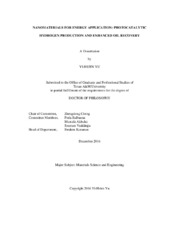| dc.description.abstract | Prediction made by U.S. Energy Information Administration, energy demand will increase more than 40% in next 30 years and renewable energy is the fastest growing energy source at an average increase rate of 2.6%. Although lots of alternative energy sources have been developed, the majority are still from fossil fuels. After primary and secondary oil recovery, 30 - 60% of original oil in place (OOIP) is left in the oil field. Additional oil could be recovered by chemical injection, or an alternative method – nanofluid injection to reduce adverse ecological concerns. The primary objects of this research were aiming at applying nanotechnology for development/modification of existing nanomaterials for energy related applications: photocatalytic hydrogen production and enhanced oil recovery.
One dimensional nanomaterials are considered favorably for electrons transport along axial direction due to the structural configuration. A green, novel, and fast microwave-assisted method was introduced to synthesize one dimensional CuO/TiO2 rods nanocomposites. Systematic investigation of deposited CuO amount on photocatalytic hydrogen production rate revealed that there was a CuO/TiO2 optimal ratio that enhanced hydrogen yield rate by 77 times. In addition, chemical vapor deposition was used to synthesize Zn3P2 nanowires and provided with in-situ surface functionalization. The surface modifier give Zn3P2 nanowires better resistance to moisture and degradation.
Two dimensional nanodisks are able to attach at oil/water interface, known as Pickering emulsion, subsequently formed extremely stable emulsion droplets. ZrP nanodisks fabricated from three synthesis methods, hydrothermal, reflux, and microwave- assisted, are characterized and evaluated. In addition to fabrication methods, solvent also plays an important role in the synthesis procedure. Selected proper solvent provides a new route to obtain ZrP nanodisks less than 100 nm.
Finally, the nanofluid containing amphiphilic ZrP nanodisks and microfluidic device for enhanced oil recovery was examined. The surface functional groups were served not only as surface modifier, but also capping agent to control the size of ZrP nanodisks in the one-pot synthesis procedure. The surface of ZrP nanodisks can be secondary functionalized to reach higher surface coverage of functional groups and further reduce interfacial tension of oil/water. The results showed oil recovery rate was increased in the presence of ZrP amphiphilic nanodisks. | en |


